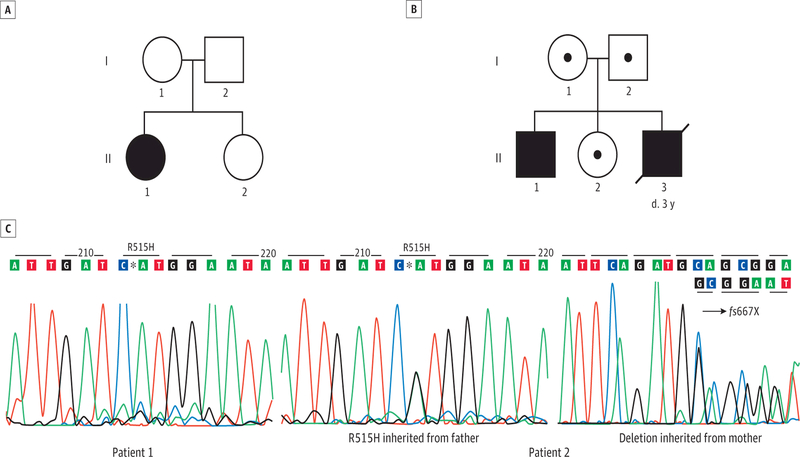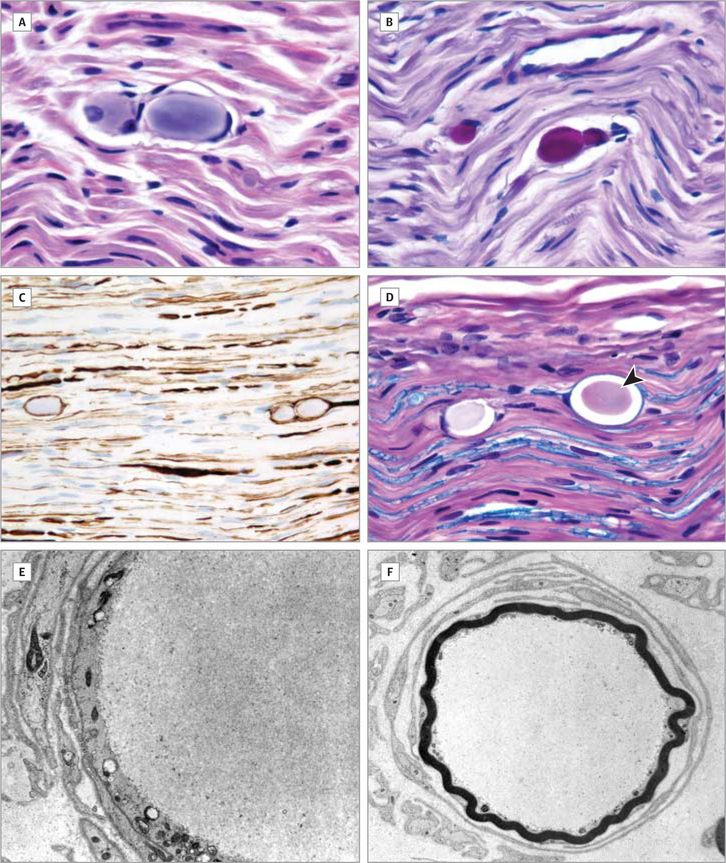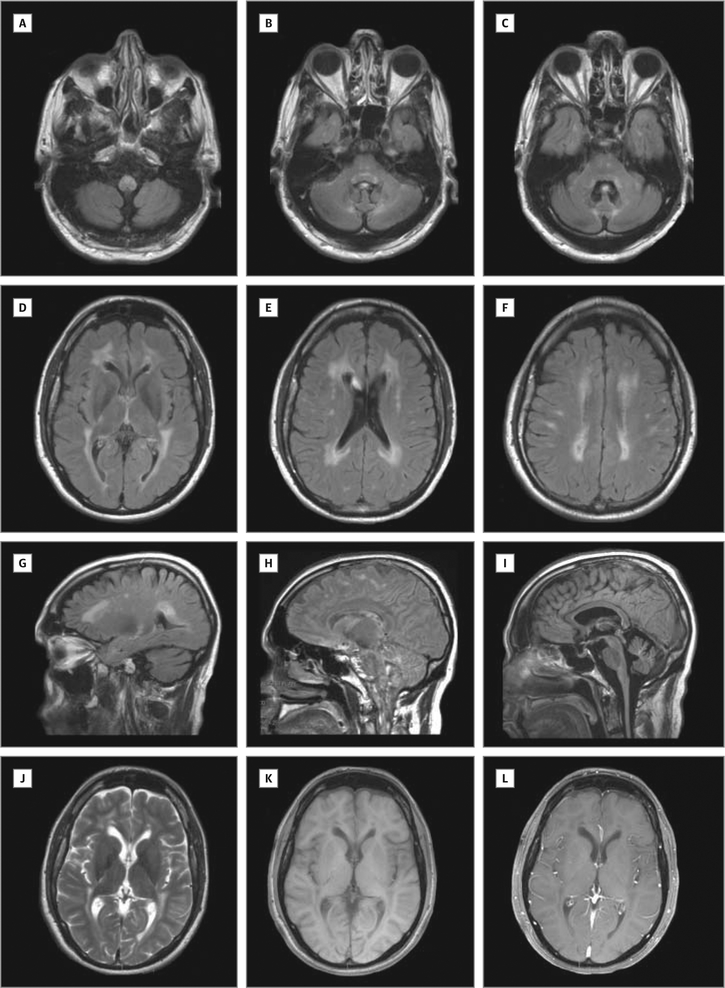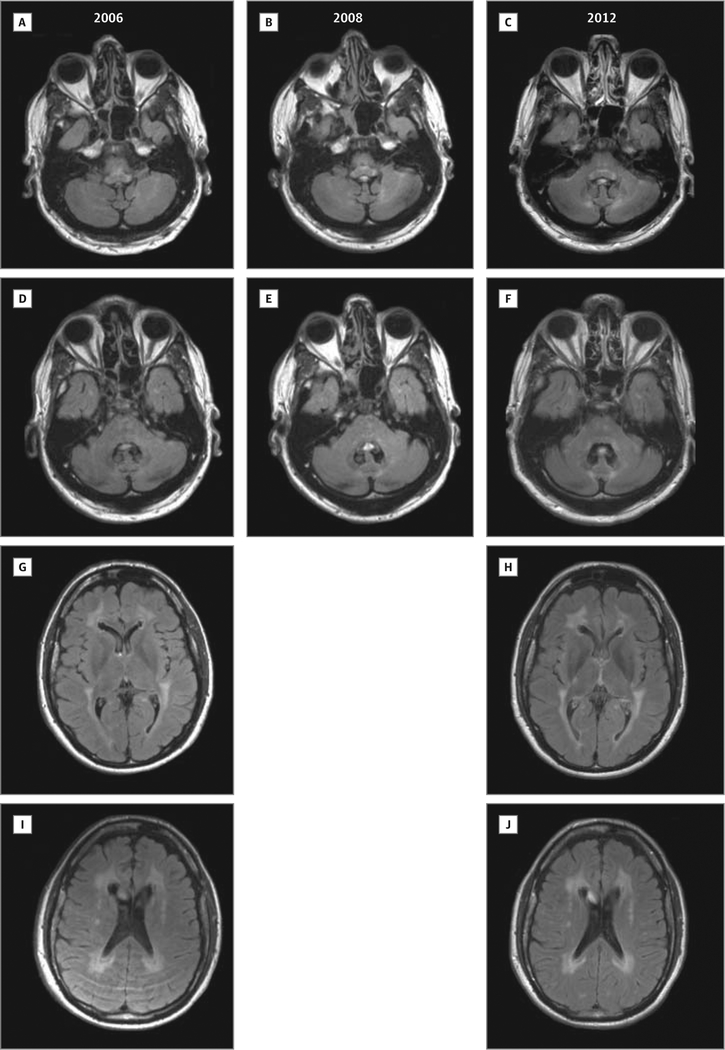Abstract
IMPORTANCE
The neuromuscular presentation of glycogen branching enzyme deficiency includes a severe infantile form and a late-onset variant known as adult polyglucosan body disease. Herein, we describe 2 patients with adult acute onset of fluctuating neurological signs and brain magnetic resonance imaging lesions simulating multiple sclerosis. A better definition of this new clinical entity is needed to facilitate diagnosis.
OBJECTIVES
To describe the clinical presentation and progression of a new intermediate variant of glycogen branching enzyme deficiency and to discuss genotype-phenotype correlations.
DESIGN, SETTING, AND PARTICIPANTS
Clinical, biochemical, morphological, and molecular study of 2 patients followed up for 6 years and 8 years at academic medical centers. The participants were 2 patients of non-Ashkenazi descent with adult acute onset of neurological signs initially diagnosed as multiple sclerosis.
MAIN OUTCOMES AND MEASURES
Clinical course, muscle and nerve morphology, longitudinal study of brain magnetic resonance imaging, and glycogen branching enzyme activity and GBE1 molecular analysis.
RESULTS
Molecular analysis showed that one patient was homozygous (c.1544G>A) and the other patient was compound heterozygous (c.1544G>A and c.1961–1962delCA) for GBE1 mutations. Residual glycogen branching enzyme activity was 16% and 30% of normal in leukocytes. Both patients manifested acute episodes of transient neurological symptoms, and neurological impairment was mild at age 45 years and 53 years. Brain magnetic resonance imaging revealed nonprogressive white matter lesions and spinocerebellar atrophy similar to typical adult polyglucosan body disease.
CONCLUSIONS AND RELEVANCE
GBE1 mutations can cause an early adult–onset relapsing-remitting form of polyglucosan body disease distinct from adult polyglucosan body disease in several ways, including younger age at onset, history of infantile liver involvement, and subacute and remitting course simulating multiple sclerosis. This should orient neurologists toward the correct diagnosis.
Mutations in the gene encoding glycogen branching enzyme (GBE1 [OMIM 232500]) cause glycogen storage disease type IV (GSD-IV).1 This autosomal recessive disorder is characterized by the accumulation of an amylopectinlike polysaccharide (polyglucosan), which is periodic acid–Schiff positive but partially resistant to diastase digestion.2 Polyglucosan accumulates in all tissues to various extents and leads to diverse clinical manifestations.3,4 The clinical spectrum of GSD-IV ranges from isolated nonprogressive hepatopathy to congenital or infantile neuromuscular disease to rapidly progressive liver cirrhosis and death in childhood, as well as adult polyglucosan body disease (APBD).2,5–7
Typically, APBD manifests in the fifth decade. It affects predominantly individuals of Ashkenazi Jewish descent and is characterized by neurogenic bladder, peripheral neuropathy, and leukodystrophy with progressive pyramidal paraparesis, while dementia is reported less consistently.8,9Early-onset acute and transient neurological symptoms similar to those of APBD have been described in a patient,10 suggesting the existence of an intermediate clinical variant “bridging” childhood GSD-IV and typical APBD. Herein, we describe 2 additional patients with acute onset of neurological symptoms evolving into a relapsing-remitting syndrome.
Methods
All procedures were approved by the Columbia University Medical Center and University of Massachusetts Memorial Medical Center institutional ethical committees on human ex perimentation. Written informed consent was obtained from both patients participating in the study.
Both patients were referred to the Department of Neurology, Columbia University Medical Center. We collected tissue samples, including skin, muscle, peripheral nerve, and peripheral blood. Laboratory investigations included electromyography, nerve conduction study, abdominal ultrasonography, brain magnetic resonance (MR) imaging, and complete blood workup with liver function tests and serum creatine kinase level. Nerve biopsy was performed in one patient. All data were obtained during 7 follow-up years (June 2006 to January 2013).
Glycogen branching enzyme (GBE) activity was assayed in cultured fibroblasts and peripheral blood lymphocytes. The method has been previously described.11Genomic DNA was extracted from peripheral blood cells according to standard procedures. The technique was based on a previously described method.11
Results
Clinical Data
Patient 1 (Figure 1A) is a 53-year-old woman of French-Canadian origin who came to our attention at age 45 years because of relapsing-remitting episodes of neurological symptoms. At age 2 years, hepatomegaly and elevated transaminase levels had prompted a liver biopsy that revealed increased glycogen. The hepatopathy resolved spontaneously. At age 44 years after a hysterectomy, she had sudden onset of difficulty writing and walking because of weakness and stiffness. Brain MR imaging performed elsewhere was interpreted as showing atrophy and nonspecific white matter changes, which led to the diagnosis of relapsing-remitting multiple sclerosis (MS) despite normal cerebrospinal fluid findings. Soon thereafter, she developed numbness in both feet, and nerve conduction studies revealed axonal sensory and motor polyneuropathy (eTable 1 in the Supplement). At age 47 years, she suddenly experienced slurred speech and loss of balance. Again, she improved over a period of weeks but did not return to baseline condition. At age 52 years, she had another acute episode of trouble walking, which improved after several days. During the past 8 years, she had noted progressively worsening urinary urgency and occasional incontinence. She now walks with the help of a cane but is able to perform all activities of daily living. At age 53 years, physical examination showed mild limb dysmetria, bilateral Babinski sign, wide-based unsteady gait, slow hand and foot tapping, and moderately decreased cold and pinprick sensation in the feet. Manual muscle strength according to the Medical Research Council12 was 5/5 for all movements except toe extension, which were 0/5. At her last visit, abdominal ultrasonography showed normal echogenicity in the liver, complete blood test results (including liver enzyme levels) were normal, and her serum creatine kinase level was 192 U/L (normal level, <297 U/L) (to convert creatine kinase level to microkatals per liter, multiply by 0.0167).
Figure 1. Pedigrees of the 2 Families and Gene Mutations.
Pedigrees of patient 1 (A) and patient 2 (B) and electropherograms showing the DNA sequences of GBE1 exon 12 in both patients and exon 15 in patient 2 (C). The nucleotide change causing the arginine to histidine substitution is indicated by an asterisk. The CA dinucleotide deletion leading to a premature stop codon is shown by the arrow. Square represents a male individual; circle, a female individual; shading, an affected individual; slash mark, a deceased individual; and central dot, a carrier. d. 3 y Indicates died at age 3 years.
Patient 2 (Figure 1B), a 43-year-old man of Italian origin, was referred because of recurrent neurological problems. At age 37 years, he had experienced an episode of leg dragging, slurred speech, and feeling “cloudy.” These symptoms had resolved within an hour. Brain MR imaging showed multiple foci of increased signal in the cerebral white matter in T2-weighted and fluid-attenuated inversion recovery (FLAIR) sequences, suggesting MS. He was treated with interferon beta-1a for the following 5 years but continued to have similar episodes, each lasting 10 to 15 minutes, with clumsiness, slurred speech, urinary urgency, and clouded mentation. He had urinary incontinence when sleeping, and urological evaluation revealed spastic bladder. At this point, an astute physician uncovered the history of a brother who had died at age 2 years of hepatopathy despite 2 liver transplants. Autopsy had showed abnormal glycogen storage in the liver, and the diagnosis of GSD-IV was considered but was not proved biochemically or genetically. When last seen at age 43 years, our patient had bilateral Babinski sign, slightly slow and clumsy foot tapping, normal gait (which became unsteady on tandem), and fine intention tremor on finger-nose-finger testing. Muscle strength was normal. Laboratory evaluation revealed normal liver enzyme levels and an increased serum creatine kinase level (370 U/L; normal level, <294 U/L). Abdominal ultrasonography showed slightly increased echogenicity in the liver. Although he had no evidence of peripheral neuropathy, nerve conduction studies demonstrated reduced amplitudes of sensory action potentials in upper and lower limbs (eTable 2 in the Supplement).
GBE Enzyme Activity
In both patients, GBE activity in leukocytes was markedly decreased. Residual GBE activity was 16% and 30% of normal in leukocytes.
GBE1 Molecular Study
Sequencing of the GBE1 gene in patient 1 disclosed a previously described homozygous c.1544G>A (p.R515H) mutation in exon 12 (Figure 1C).10,13 The GBE1 gene in patient 2 harbored 2 different mutations, one missense (c.1544G>A; p.R515H) in exon 12 and the other frameshift (c.1961–1962delCA) in exon 15, resulting in a premature stop codon that truncated the protein. Sequencing of the GBE1 gene in both patients documented that the mutations were located in different alleles. To our knowledge, the frame-shift mutation has not been previously reported (http://useast.ensembl.org/index.html and http://www.hgmd.cf.ac.uk/ac/all.php).
Nerve Biopsy
A sural nerve biopsy specimen from patient 1 revealed intracytoplasmic inclusions in neuronal axons (Figure 2). The inclusions were faintly basophilic in routine hematoxylin-eosin–stained sections but reacted intensely to periodic acid–Schiff stain, with moderate resistance to diastase digestion, which is typical of polyglucosan bodies. The axonal location of the polyglucosan bodies was confirmed by neurofilament immunostaining and Luxol fast blue staining for myelin. The arrow in Figure 2 points to a polyglucosan body surrounded by blue myelin stain. Electron microscopic examination revealed non–membrane-bound cytoplasmic inclusions composed of densely packed, finely granular, and short fibrillar material resembling amylopectin, within axons surrounded by attenuated myelin sheaths.
Figure 2. Polyglucosan Bodies in Sural Nerve.
A and B, Polyglucosan bodies appear faintly basophilic with hematoxylin-eosin stain (A) but show intensely positive reactions with periodic acid–Schiff stain (B). C, Polyglucosan bodies are surrounded by neural filament–positive material. D, Luxol fast blue staining for myelin also localizes polyglucosan bodies in neuronal axons (arrowhead). E and F, Electron micrographs show storage of thin filamentous material in the cytosol (E) and within a myelinated nerve fiber surrounded by several Schwann cell processes (F). Original magnification ×40 (B and C), ×60 (A and D), ×4000 (F), and ×6000 (E).
Brain MR Imaging
On a 1.5-T magnet MR imaging system, we obtained FLAIR images, diffusion-weighted images with apparent diffusion coefficient mapping, and T1-weighted sequences before and after contrast administration, as well as T2-weighted sequences with fat suppression. FLAIR and T2-weighted images in both patients showed symmetric white matter changes in the cerebellar peduncles, periventricular regions, posterior limb of the internal capsule, and medial lemnisci of the medulla and pons. Scattered subcortical parietal lesions were also identified but were not detected in T1-weighted sequences. After contrast administration, no areas of abnormal enhancement were evident. Medullary, vermian, and spinal atrophy was also observed at cervical and dorsal levels (Figure 3 and eFigure in the Supplement). In patient 2, MR imaging studies performed in 2006 and in 2012 showed mild worsening of the lesions in the cerebellar peduncles (Figure 4).
Figure 3. Brain Magnetic Resonance Imaging in Patient 2.
Brain magnetic resonance images of patient 2 showed the typical cerebral and spinal pattern described in patients with adult polyglucosan body disease. A-H, Fluid-attenuated inversion recovery sequences showed symmetric hyperintense white matter lesions in the pyramidal tracts of the medulla (A), pons (B), cerebellar peduncles (C), and periventricular regions (D-G), as well as (to a lesser degree) in the external capsule and the posterior limb of the internal capsule (D) and in subcortical areas (H). I, Axial T1-weighted sequences showed medullary, spinal, and vermian atrophy. J, The T2-weighted images showed a similar but less well-defined pattern. K and L, The abnormal white matter areas had normal signal on T1-weighted images and showed no enhancement after contrast administration.
Figure 4. Longitudinal Study of Brain Magnetic Resonance Imaging in Patient 2.
Sequential brain magnetic resonance images of patient 2 in 2006 (A, D, G, and I), 2008 (B and E), and 2012 (C, F, H, and J) showed mild increases in the size of white matter lesions in the cerebellar peduncles (C and F). All other lesions were unchanged during the follow-up period (G-J).
Discussion
We describe an atypical variant of branching enzyme deficiency in 2 patients who manifested an acute presentation in young adulthood and who had a relapsing-remitting course. A similar case was reported in 2013 in a woman with an acute presentation of APBD-like symptoms at age 37 years, fol lowed by almost complete recovery10; however, her long-term outcome is unknown.
In 1996, McConkie-Rosell et al14 described 4 patients with nonprogressive liver disease: the liver enzyme levels returned to normal in 2 patients within 3 years and remained normal until age 13 years and 20 years. However, it was reported in 2012 that one of them had developed symptoms of typical APBD in his fourth decade.8 Similarly, patient 1 herein had manifested a liver disorder in infancy; although the disease presentation in patient 2 had occurred in adulthood, his brother had died in childhood after repeat liver transplantation.
Their unusual clinical course does not allow us to classify our patients as having classic infantile GSD-IV or typical APBD but seems to bridge the 2 conditions and to delineate an intermediate clinical variant. Our data also reinforce previous recommendations to carefully monitor patients with apparently isolated liver disease for the appearance of neurological symptoms, which would argue against liver transplantation.14
Adult patients like ours with subacute or acute neurological presentations invite various diagnoses, including MS, stroke, and Guillain-Barré syndrome. To further complicate matters, laboratory test results (eg, brain MR imaging and nerve conduction studies) show abnormal findings typically seen in APBD but not specific enough to rule out the aforementioned diseases. However, our results and the previous evidence suggest that brain MR imaging provides important diagnostic clues. Although the general pattern of signal abnormalities associated with APBD resembles that of MS lesions, some abnormalities are so characteristic and consistent as to suggest APBD unequivocally. These include medullary and spinal atrophy, together with hyperintense white matter abnormalities on T2-weighted and FLAIR sequences in the pons, medulla, cerebellar peduncles, and internal and external capsules, as well as the occipital lobes.8,15 Although the few subcortical lesions in patient 1 suggested the diagnosis of MS, both patients showed the typical leukodystrophy pattern of APBD. The risk of misdiag-nosing MS decreases when the subcortical lesions fail to show contrast enhancement; therefore, the use of gadolinium is strongly recommended, especially when the presentation is monophasic.
A 2012 description of the natural history of APBD showed that brain MR imaging remained unchanged from the first appearance of symptoms; this conclusion was based on the observation that lesions were similar at different stages of the disease.8 Our longitudinal brain MR imaging study in patient 2 supports this concept because we observed the same leuko-dystrophy pattern 6 years after the first study, with only minimal progression at the level of the cerebellar peduncles. Therefore, the intermediate phenotype that we describe has a clinical presentation distinct from that of typical APBD but has undistinguishable brain imaging features.
Liver dysfunction is common in infantile GSD-IV and ranges from nonprogressive liver disease to liver cirrhosis.14,16,17 However, hepatopathy has not been described in typical APBD to date. As a further distinguishing feature from APBD, patient 1 had a history of hepatopathy in infancy, although the neurological symptoms appeared much later. Long-term clinical follow-up data in 2 patients with GSD-IV manifesting reversible hepatopathy in childhood showed no neurological involvement, at least up to age 13 years and 20 years.14,16 Whether these patients will develop neurological symptoms in adulthood remains uncertain, but the clinical course in patient 1 herein supports the notion that transient liver disease in in fancy may presage the intermediate form of APBD. We suggest consideration of this differential in adult patients with acute neurological symptoms of uncertain diagnosis and a history of liver disease in childhood; sequencing the GBE1 gene in blood DNA could easily and noninvasively define the presence of this diagnosis.
Can we glean a genotype-phenotype correlation in the late-onset forms of GSD-IV? Adult polyglucosan body disease predominates among individuals of Ashkenazi Jewish descent who share the same mutation (p.Y329S), probably due to a founder effect.8 The substantial residual enzyme activity associated with this mutation may explain the late onset of symptoms,18 but other mutations that result in less residual activity have also been associated with APBD in non-Ashkenazi patients. Predictably, none of the mutations detected in patients with the severe infantile neuromuscular presentation have been seen in APBD or in the nonprogressive hepatic form, whereas the 2 milder phenotypes share some mutations, including p.Y329S and p.L224P.5,8,18 The p.R515H mutation found in both of our patients had been previously reported in 2 cases: one was a compound heterozygous non-Ashkenazi patient with onset of APBD at age 46 years described by Ziemssen et al,13 and the other was the patient with acute transient presentation at age 35 years described by Billot et al.10 The c.1961–1962delCA mutation in our patient 2 is novel: whether this mutation also contributes to a milder phenotype remains to be established.
In conclusion, the 2 patients described herein contribute to the definition of an intermediate form of GBE deficiency with predominant involvement of the central and peripheral nervous system but distinct from typical APBD because of several characteristics. These differences include the following: (1) the patients were non-Ashkenazi, (2) onset was in adulthood but at least 1 decade earlier than in typical APBD, (3) the frequent relapsing-remitting course and the white matter lesions led to a diagnosis of MS, and (4) a history of childhood liver disease in the patient or in a family member was an important clue to the correct diagnosis.
Supplementary Material
Acknowledgments
Funding/Support: This research was supported by fellowship BA12/0097 from the Spanish Government, Instituto de Salud Carlos III, Ministerio de Economia y Competitividad, Madrid, Spain (Dr Paradas); by the Adult Polyglucosan Body Disease Research Foundation (Dr Akman); and by the Muscular Dystrophy Association (Dr Akman).
Footnotes
Conflict of Interest Disclosures: Dr Ionete has received research support from Genzyme Corporation and Biogen Idec. Dr Lau has received research support from Genzyme Corporation, Biomarin, Shire, Amicus, and GlaxoSmithKline and has received compensation as a consultant to Pfizer. Dr Riskind has consulted for Genzyme Corporation and has received research support from Genzyme Corporation, Biogen Idec, sanofi-aventis, Roche, Genentech, Novartis, Teva Pharmaceuticals Industries LTD, Bayer, ACP, and EMD Serono. Dr Hirano has received honoraria as a member of the Athena Diagnostic Speakers’ Bureau. Dr Jones received research support from Biogen Idec, Genzyme Corporation, and Novartis; consulting compensation from Biogen Idec, Genzyme Corporation, and EMD Serono; and speaking honoraria from Biogen Idec, Novartis, EMD Serono, and Teva Pharmaceuticals Industries LTD. Dr DiMauro receives compensation as a member of the editorial board of MedLink Neurology. No other disclosures were reported.
Role of the Sponsor: The Adult Polyglucosan Body Disease Research Foundation, the Muscular Dystrophy Association, and the Spanish Government had no role in the design and conduct of the study; collection, management, analysis, and interpretation of the data; preparation, review, and approval of the manuscript; and decision to submit the manuscript for publication.
REFERENCES
- 1.Magoulas PL, El-Hattab AW. Glycogen storage disease type IV [Internet] In: Pagon RA, Adam MP, Bird TD, Dolan CR, Fong CT, Stephens K, eds. GeneReviews. Seattle: University of Washington; 1993–2013. [PubMed] [Google Scholar]
- 2.Schröder JM, May R, Shin YS, Sigmund M, Nase-Hüppmeier S. Juvenile hereditary polyglucosan body disease with complete branching enzyme deficiency (type IV glycogenosis). Acta Neuropathol. 1993;85(4):419–430. [DOI] [PubMed] [Google Scholar]
- 3.Bruno C, Servidei S, Shanske S, et al. Glycogen branching enzyme deficiency in adult polyglucosan body disease. Ann Neurol. 1993;33(1):88–93. [DOI] [PubMed] [Google Scholar]
- 4.Moses SW, Parvari R. The variable presentations of glycogen storage disease type IV. Curr Mol Med. 2002;2(2):177–188. [DOI] [PubMed] [Google Scholar]
- 5.Bruno C, van Diggelen OP, Cassandrini D, et al. Clinical and genetic heterogeneity of branching enzyme deficiency (glycogenosis type IV). Neurology. 2004;63(6):1053–1058. [DOI] [PubMed] [Google Scholar]
- 6.Ravenscroft G, Thompson EM, Todd EJ, et al. Whole exome sequencing in foetal akinesia expands the genotype-phenotype spectrum of GBE1 glycogen storage disease mutations. Neuromuscul Disord. 2013;23(2):165–169. [DOI] [PubMed] [Google Scholar]
- 7.Tang TT, Segura AD, Chen YT, et al. Neonatal hypotonia and cardiomyopathy secondary to type IV glycogenosis. Acta Neuropathol. 1994;87(5):531–536. [DOI] [PubMed] [Google Scholar]
- 8.Mochel F, Schiffmann R, Steenweg ME, et al. Adult polyglucosan body disease. Ann Neurol. 2012;72(3):433–441. [DOI] [PMC free article] [PubMed] [Google Scholar]
- 9.Robitaille Y, Carpenter S, Karpati G, DiMauro SD. A distinct form of adult polyglucosan body disease with massive involvement of central and peripheral neuronal processes and astrocytes. Brain. 1980;103(2):315–336. [DOI] [PubMed] [Google Scholar]
- 10.Billot S, Hervé D, Akman HO, et al. Acute but transient neurological deterioration revealing adult polyglucosan body disease. J Neurol Sci. 2013;324(1–2):179–182. [DOI] [PubMed] [Google Scholar]
- 11.Tay SK, Akman HO, Chung WK, et al. Fatal infantile neuromuscular presentation of glycogen storage disease type IV. Neuromuscul Disord. 2004;14(4):253–260. [DOI] [PubMed] [Google Scholar]
- 12.Medical Research Council. Aids to the Examination of the Peripheral Nervous System. London, England: Her Majesty’s Stationery Office; 1981. Memorandum 45. [Google Scholar]
- 13.Ziemssen F, Sindern E, Schröder JM, et al. Novel missense mutations in the glycogen-branching enzyme gene in adult polyglucosan body disease. Ann Neurol. 2000;47(4):536–540. [PubMed] [Google Scholar]
- 14.McConkie-Rosell A, Wilson C, Piccoli DA, et al. Clinical and laboratory findings in four patients with the non-progressive hepatic form of type IV glycogen storage disease. J Inherit Metab Dis. 1996;19(1):51–58. [DOI] [PubMed] [Google Scholar]
- 15.Klein CJ, Boes CJ, Chapin JE, et al. Adult polyglucosan body disease. Muscle Nerve. 2004;29(2):323–328. [DOI] [PubMed] [Google Scholar]
- 16.Greene HL, Brown BI, McClenathan DT, Agostini RM Jr, Taylor SR. A new variant of type IV glycogenosis. Hepatology. 1988;8(2):302–306. [DOI] [PubMed] [Google Scholar]
- 17.Guerra AS, van Diggelen OP, Carneiro F, Tsou RM, Simoes S, Santos NT. A juvenile variant of glycogenosis IV (Andersen disease). Eur J Pediatr. 1986;145(3):179–181. [DOI] [PubMed] [Google Scholar]
- 18.Bao Y, Kishnani P, Wu JY, Chen YT. Hepatic and neuromuscular forms of glycogen storage disease type IV caused by mutations in the same glycogen-branching enzyme gene. J Clin Invest. 1996;97(4):941–948. [DOI] [PMC free article] [PubMed] [Google Scholar]
Associated Data
This section collects any data citations, data availability statements, or supplementary materials included in this article.






